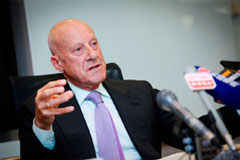Foster on Foster’s plan
 “I remember overhearing someone said, if you ask Norman a question he would do a drawing,” said Lord Norman Foster, who tried to calm an anxious crowd with an amusing opening, notably without his favourite yellow Pentel mechanical pencil. “Anytime I talk about architecture I have images.” “I remember overhearing someone said, if you ask Norman a question he would do a drawing,” said Lord Norman Foster, who tried to calm an anxious crowd with an amusing opening, notably without his favourite yellow Pentel mechanical pencil. “Anytime I talk about architecture I have images.”
For a change, he spent half an hour talking about his design concept in the West Kowloon Cultural District to a packed room of two dozen reporters who came right after the Typhoon Nesat was away. The typhoon spoiled an original grand opening ceremony on September 29th and left Lord Foster speaking like a professor in a tiny lecture hall without even a blackboard.
“For me this project started 32 years ago when I first came to Hong Kong to be interviewed for a competition for the bank,” said the 76 year-old world renowned architect and designer, recalling his first masterpiece here, the HSBC headquarters. “I remember at the time was totally overwhelmed.”
Apart from setting his architectural eye on the dimension of the narrow streets, the stacking of tall buildings with layers one on top of the other, Lord Foster is particularly impressed with what he coined as the DNA of this city, which he defined as a place with strong sense of identity that when one comes and lives here, he would not confuse it with other cities of the world.
That is, in a word, vitality.
Before embarking on the design competition of West Kowloon Cultural District last year, he asked his team some key questions that set the tone of his design concept.
He recalled, “If you try to improve Hong Kong, what would you do? What would be your starting point? If you can improve traffic, if you can reduce pollution and noise, it would be even better. I like more green space, and the post-card view. I like to have both worlds: the vitality and the urban quality.”
That is in essence his concept that extends and embeds the city’s major cultural facilities, that includes the world’s best cinema, theatre, concert hall and museum, along with a Chinese culture centre (the Xiqu Centre), the Hong Kong’s biggest performance venue, and one of the biggest parks.
In his enhanced version, Foster designed the main route as The Avenue, physically modeled on Nathan Road, interspersed by three public squares – Xiqu Square, Central Square and Artist Square – for leisure and open space.
Creating a Chinese culture centre around the Xiqu Square is an example of how Foster taking wisdom from the other designers. The Centre also includes a Xiqu Theatre, which schedules to complete by 2015, with a covered Chinese market place.
To make it a complete design plan, Foster also adopted a dozen of desirable features, such as Arts Pavilions, Banyan Farm concept in Outdoor theatre, green roofs on buildings and wing turbines, from the other two conceptual plans that were expressed by the public.
Refuting some mish-mesh criticisms, Lord Foster responded, “I sincerely do not believe the seeking of opinion on how you can improve compromises the project. The opposite is the case.
“This project is better now than it was a year ago and it would be better the month after and it would be better next year.”
“I think this scheme is absolutely incredible. There is no initiative - politically and culturally - nothing in this scale which celebrates culture anywhere in the world,” Foster said.
One concept that Foster insists is to make the district greener and cleaner as much as possible. That is why he puts public transports underground, leaving a maximum open space and fresh air to ensure the people who visit the district would feel a comfortable and beautiful environment.
As part of the team to build the West Kowloon dream, Foster said, “On this project, we have put our everything into it and we would continue to do so. If it doesn’t turn out to be the best of its kind in the world, I would be very surprised.”
 For a glimpse of how Foster integrates into the West Kowloon work, consider the light-hearted dialogue between Foster and the West Kowloon Cultural District management team that emerged towards the end of the press conference. For a glimpse of how Foster integrates into the West Kowloon work, consider the light-hearted dialogue between Foster and the West Kowloon Cultural District management team that emerged towards the end of the press conference.
Chief Executive Officer Michael Lynch: This big project requires a lot of engagements over many terms of governments and regimes but the way to do it is to adopt the master plan over a period of time where most of us would be here.
Board member Ronald Arculli: Instead of most of you, I think all of us will be around.
Norman Foster: Some of us are more impatient than others.
Michael Lynch: With very good reasons
|

